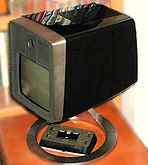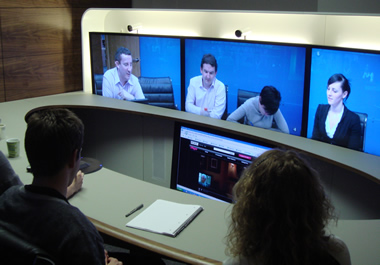
I was amazed to learn that idea for a Video Phone predate's the word "video" itself, coined in 1935.
Within two years of the 1876 invention of telephone, a personal video phone known as a "telephonoscope" was conceptualized and popularized in the press. Such a device, it was asserted, would allow merchants to transmit pictures of their wares to customers in distant cities.
Alexander Graham Bell himself went on to predict that: "...the day would come when the man at the telephone would be able to see the distant person to whom he was speaking." Yet, for most of us, visual telephony is far from an everyday experience.
So where's our video phone?
The technology emerged by the 1920's that allowed television to be deployed. Inspired by radio and constrained by cost, television emerged as the one-to-many broadcast system we know today.

Video phone in its basic form first became a reality in prewar Germany, but was quickly shelved due to the conflict. AT&T deployed its one-to-one "Picturephone" in the 1960's and again in the 1990's, but the high cost and requirement that both parties use specialized equipment hampered adoption.
Business-grade video conferencing became available in the 1980's over the Public Switch Telephone Network (PSTN), but required specialized equipment and high cost T-1 or ISDN connections at both ends. The PSTN has mostly been used to connect callers with human operators and to IVR systems, where callers are often frustrated by long waits associate with the serial presentation of audio selections.

With the advent of Internet in the 1990's, these services have all been re-imagined. Video conferencing systems are now available as IP-based systems but have mostly been displaced by Internet meeting services like Cisco WebEx, GoToMeeting, and Fuze Meeting in all but the high end of the market, where room-to-room "telepresence" systems endure. Video services like Skype, Facetime, and other visual services have been deployed to provide visual interaction and/or desktop sharing on a one-to-many and one-to-one basis.
All of these services bypass the PSTN as they are initiated and conducted by means of the IP-based network, often with a concurrent voice session where participants call-in and enter a "room number" to bridge into a conference call. Sessions are initiated either by entering an Internet address, clicking a link, or by the use of a proxy that connects two users from point to point over IP-based network.
Yet, the consistent reliably of a voice call and convenience of the PSTN dial-pad access endures. Most merchants promote both their Internet address to visually connect with their content servers, i.e. website, and their phone number to voice connect with a human operator over the PSTN.

In addition, merchants often present phone numbers on their websites and/or direct voice callers to the website address in their introductory announcements. For example, callers to Southwest Airlines will be greeted with the message "Lower fares may be found at Southwest.com." Current integration takes the form of an Internet chat session or click-to-call button, where consumers are connected by voice via a VOIP session or can initiate a call back over the PSTN.
Most telephone applications are limited to voice and touchtone telephony communications. When dynamic, interactive visual content is desired in real time, consumers use the Internet, where visual information is robust but neither synchronized to the automated telephone application nor visible to a sales agent.

A typical sales inquiry typically includes a phone call where the agent instructs the hapless consumer to click to the relevant section of the merchants website to "see" the product and features being discussed. Or, if the voice call is initiated by the consumer, the consumer is left to describe where they are in the merchants website so the agent may catch up and follow along. Either may become a frustrating experience.
Finally, the PSTN is slated to become IP-based and, with that, visual telephony services like video conferencing and content sharing will become inherent in the IP platform. Indeed, in late 2011 the FCC held its first workshop to explore this topic entitled the "THE PUBLIC SWITCHED TELEPHONE NETWORK (PSTN) IN TRANSITION."
Yet, concerns over public safety, disability access, and rural access will slow the transition to an IP-based phone system, and there is currently no clear path forward.
So, where's our Video Phone? Will it require some eNum-bo-Jumbo? Will it work with Grandma's home phone? Stay tuned.... It's closer than you think!
Believe. You can!